|

|
|

|
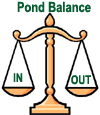 Plants are an important part of most backyard ponds. Of
course, they add to the appearance of the pond, both in the water and
along the edges but they also help reduce algae growth, keep the pond
cool and provide places for fish to hide and reproduce. Plants are an important part of most backyard ponds. Of
course, they add to the appearance of the pond, both in the water and
along the edges but they also help reduce algae growth, keep the pond
cool and provide places for fish to hide and reproduce.
There are many categories of plants for use in and around
our ponds. The first considerations would be whether the plants are
winter hardy or tropical.
|
-
Tropical Plants
- The tropics are areas of the world where
the temperatures never drop below freezing. As soon as the water
temperature approaches freezing, these plants will begin to die. In
temperate zones (where we have four distinct seasons) these plants are
either used as expensive annuals or must be taken indoors to survive.
|
Within these two categories of plants, there are several
other groupings depending on the growth mechanism for each type. These
would include:
-
 Floating Plants
- Plants such as sea lettuce and water
hyacinth do not attach roots to soil. They float freely on the surface
with their roots suspended in the water and they draw their nutrient
from it. Floating Plants
- Plants such as sea lettuce and water
hyacinth do not attach roots to soil. They float freely on the surface
with their roots suspended in the water and they draw their nutrient
from it.
-
Bottom Plants
- These plants need soil in which to sink
their roots. They stay in one place and some of them send their
foliage to or above the surface of the water. Water lilies, iris and
many other plants belong to this category. Most so-called "oxygenators"
also belong to this group.

-
Pond Edge Plants
- Traditional landscape annuals, biennials
and perennials may be used along the edge of the pond. These are
intended to make a transition between the water and the terra
firma.
-
Bog Plants
- On the edge of most natural ponds or lakes
is an area that is moist most of the time and a group of plants
has adapted to this type of growing condition. Most landscape
plants need a well-drained soil but bog plants can withstand and
thrive in wet soils.
-
Landscape Plants - These are plants that need a
well-drained soil
 for proper growth. Trees and shrubs as well as
annuals and perennials add a great deal to the pond by reflecting
on its surface. Whether grown in the soil or in containers, these
plants form a vital part of a successful backyard pond. for proper growth. Trees and shrubs as well as
annuals and perennials add a great deal to the pond by reflecting
on its surface. Whether grown in the soil or in containers, these
plants form a vital part of a successful backyard pond.
Again, each of these two groupings may also be broken
down further to:
-
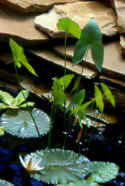 Foliage Plants - Some plants such as taro are grown
primarily for their colorful or uniquely shaped foliage. Flowers, if
any, are strictly secondary. Foliage Plants - Some plants such as taro are grown
primarily for their colorful or uniquely shaped foliage. Flowers, if
any, are strictly secondary.
-
Flowering Plants - Many of the flowers in the categories
listed above are grown for their beautiful flowers. Probably the most
commonly grown flowering plants are the hardy
water lilies, tropical water
lilies and lotus.
|
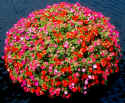
Floating containers filled with bright
flowers can add interest t o the larger pond. However, be
careful not to overdo this effect. Also, it will not be compatable with an informal pond arrangement. o the larger pond. However, be
careful not to overdo this effect. Also, it will not be compatable with an informal pond arrangement.
|
|
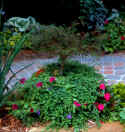 Potted trees such as the Japanese maple (above)
and the peach tree (right) may be placed next to the pond to
provide a vertical effect. Also, their reflection in the pond
will add to the serenity of the area. Potted trees such as the Japanese maple (above)
and the peach tree (right) may be placed next to the pond to
provide a vertical effect. Also, their reflection in the pond
will add to the serenity of the area.
|
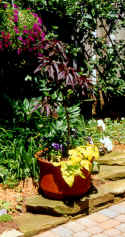 |
|
|



